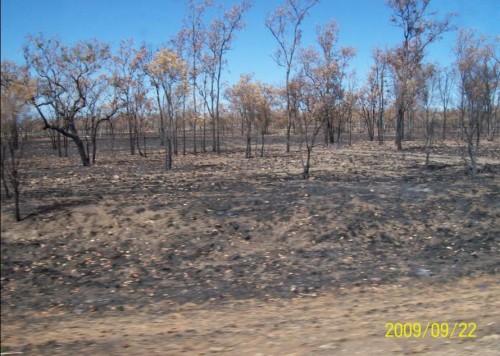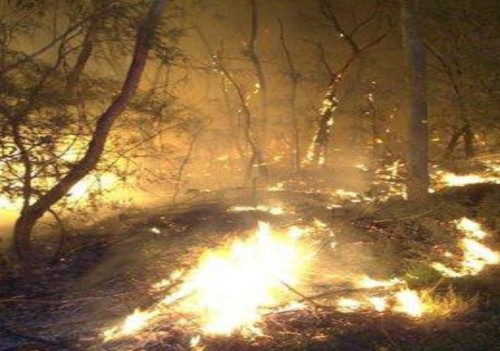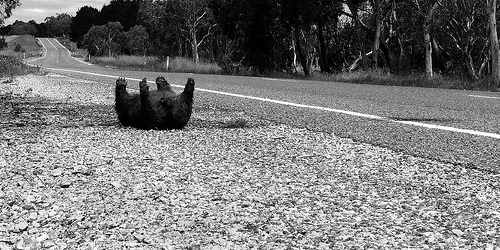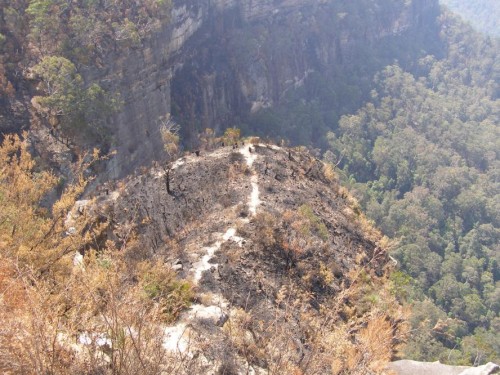‘Ecological Burning’ – a myth, an ‘eco-crime’
Thursday, May 26th, 2011.
– – – – – –.
.
From the frying pan…
.
When bushfire management can contrive no other excuse for setting fire to native vegetation, like when native vegetation is many miles away from human settlement and so poses no direct threat; out comes a concocted academic theory called: ‘ecological burning ‘. Over how many beers?
When those in whom our community trusts to put out bushfires, decide instead to start setting fires to bushland, and descend instantly into a betrayal of that that trust, to whom can our community entrust to put out bushfires? Government has been proven to suck.
What has happened to ecological values of the bush and the sense of urgency to put out bushfires that threaten both it and us?
.
‘Ecological Burn’ Theory
.
- The ‘ecological burn’ theory starts with the premise that because humans have observed that the Australian bush ‘grows back’ (eventually) after a bushfire, it may be concluded that the Australian bush can tolerate bushfires. This hypothesis relies on evidence that selected species of Australian germinate after smoke and fire and the example of epicormic growth of many Eucalypts after fire.
- The deductive fallacy of this theory is that all the Australian bush is bushfire tolerant.
- This deduction is then extended by unsupported assumption that since the Australian bush is bushfire-tolerant, bushfire must be an integral natural process to which the Australian bush has become adapted to bushfire.
- The assumption is then extrapolated to assert that bushfire is indeed beneficial to the Australian bush.
- The assumption is then stretched even further to conclude that without bushfire the Australian bush will be adversely affected.
- The ecological burn theory then prescribes that by burning the Australian bush, whether by natural or unnatural means, the biodiversity of the Australian bush will be improved.
- The deductive fallacy goes further, to suit the motives of the fire-lighters. The outrageous generalisation is made that all the Australian bush must be burnt at some stage for its own ecological benefit.
.
So the ‘Ecological Burn’ mantra has become:
‘Go forth and burn wilderness. It’ll grow back. It’ll do it good.‘
.
.
Habitat ‘fuel’ gone…so it wont burn now!
.
The perverted irrational logic that Australia’s native vegetation has adapted to recover from bushfire is akin to claiming the human body is adapted to recover from injury such as burns. A wound may heal but no-one seeks to be injured in the first place. And not all wounds heal. A third degree burn to more than 50% of a human body is almost a certain death sentence. What percentage of a wild animal’s body can be burnt and the animal still survive? That’s a perverted question for the fire-lighters.
Broadscale hazard reduction is not mosaic patch-work fire. It is not creating a small scale asset protection zone around the immediate boundary of a human settlement. It is wholesale bush arson that is driving local extinctions. Ever wonder why when bush walking through the Australian bush so few native animals are seen these days? Their natural populations have been decimated through two centuries of human harm – mainly poaching, introduced predation and habitat destruction including by human-caused bushfires and human-abandoned bushfires.
 Broadscale incineration of native bushland across northern Queensland
by the Rural Fire Service Queensland.
Habitat ‘fuel’ gone ~ so it won’t burn now!
Broadscale incineration of native bushland across northern Queensland
by the Rural Fire Service Queensland.
Habitat ‘fuel’ gone ~ so it won’t burn now!©Photo by Ann Jurrjens, 20090922. (click photo to enlarge, then click again to enlarge again).
..
.
.
.
Likely Origins of the ‘Ecological Burn’ myth
.
The concept of the ‘ecological burn’ sounds like the academic contrivance that it is. It is an outpouring from a handful of forestry academics who have successfully sold their consulting services to government under a similarly contrived expertise of being ‘fire ecologists‘ or ‘fire scientists‘. Well, at least ‘garbologists‘ work for a living.
After a major bushfire, an affected and sometimes devastated public cries for answers and the media cash in with their newspaper-selling witch hunt. The responsible government politicians and department directors of the bushfire management deflect accountability away from themselves by instigating a tried and tested ‘bushfire enquiry‘. Those enquiries seek expert evidence and so the ‘fire ecologists’ come out of the woodwork, professing expert insight into the reasons for uncontrolled bushfire and contriving theories for better bushfire management. They invariably proclaim ‘I told you so!
With the frequency of uncontrolled bushfires year after year, there have been so many enquiries across Australia, sufficient to fill bookshelves; each one wastefully gathering dust. Yet with the almost annual disaster recurrence somewhere across Australia, the relevance of ‘fire ecologists’ has morphed fire ecology into an almost full-time occupation – generally on the payroll of the government agencies seeking to justify excuses why they didn’t put out the bushfires in the first place.
The origins of ‘fire ecology’ and to the ‘ecological burn’ theory may be at least traced back to Victoria, an Australian state with perhaps the worst record of bushfire management in the country. During 1999 a series of ‘Fire Ecology Workshops’ were held at Country Fire Authority stations across the state. In that year the ‘Interim Guidelines an Procedures for Ecological Burning‘ was published by Victorian Government’s departments: Natural Resources and Environment and Parks Victoria. References to this and related documents may be found by following the links under References below.
It must have been like an evangelistic mission by these new ‘fire ecologists’, leveraging the common human terror of fire into a way of dealing with that fear once and for all. The final solution would go beyond ‘back-burning‘, beyond the ‘controlled burn‘, beyond ‘hazard reduction‘. It means burning the bush before it burns; but this time on a massive scale, taking the fire-fight to wilderness.
The ‘ecological burn’ theory has gone further. It has brainwashed fire-fighters and natural land managers into believing that burning the bush is indeed good for the bush, good for biodiversity. This is a paradigm cultural shift to a sense of ecological righteousness – by burning the bush you are doing biodiversity a favour. And the fire scientists’ proof of their theory is down to the epicormic growth and the selected native plant species shown to be fire-tolerant, and with that fire-tolerance must be ecologically sustainability. As soon as some green regrowth occurs, they are out taking photos to support and promulgate their theory. ‘Look it grows back’ they claim. Except that these same species that recover from fire have ended up dominating the natural landscape.
 Fire-Lighters’ bliss
.
Fire-Lighters’ bliss
.‘A Firelighters’ Bliss‘:.
‘a state of profound satisfaction in lighting a bushfire, the equivalent happiness and joy in doing so, a constant pyromaniac state of mind, undisturbed by gain or loss, so long as the lit bush burns fiercely’. i.e. the aroused state of ignition frenzy by either a closet, suspected or convicted bush-arsonist!
.
So forget Aboriginal traditional mosaic burning theory – so passé and so ineffective (below napalm baseline). So the message is officially clear, if you want to avert calamities like Black Friday, Black Saturday and the demonising of the rest of the days of the week, burn the bush in swathes, lest it burn you first. The theory is ecological satanism. It is up there with the Y2K bug. It has led a wholesale conversion of bush fire-fighters into fire-lighters on a grand scale akin to scientology’s hold on young people in the 1970s. It has culminated in an escalation of prescribed burning to an extent well outside any reasonable justification for protecting human life and property from the risk of bushfire. The ‘ecological burning’ extremists evangelise is that burning should be ‘strategic’ and for strategic zones spanning thousands of hectares of wilderness to be targeted for burning. What they avoid problem-solving is why they don’t put out the ignitions in the first place.
‘Ecological fire’ is a myth that has festered into the greatest ‘eco-crime’ in Australia’s history, second only to 19th and 20th Century widespread clear-felling. The ‘ecological fire’ myth is the most devastating driver of man-made extinctions plaguing Australia in the 21st Century.
.
A Test for ‘Fire Ecologists’:
.
Name one case study in Australia published in a peer-recognised scientific journal… in which independent wildlife ecologists have conducted proper before-and-after field tests of fauna-and-flora-biodiversity…where natural (pre-1788) biodiversity has been found to flourish… as a provable result of a broadscale ecological burn!
.
In August 2000, possibly the country’s chief druid of bushphobia, Kevin Tolhurst, produced a report seeking to justify the previous year’s setting fire to most of the Mount Cole State Forest, situated over 20km east of the town of Ararat in Victoria’s central west district. At the time, Tolhurst was part of the School of Forestry at the University of Melbourne.
Part of the report included, Appendix 3: Guidelines for the Ecological Burning in foothill forests of Victoria, in which an overview of the Mt Cole Case Study was provided. Notably, this report is provided not found on the University of Melbourne website, but that of the Department of Primary Industries of Victoria website. Clearly the ‘ecological burning’ concept stems not from preferred prestigious academic credentials, but moreso from politically motivated Primary Industries exploitive expedience.
The primary vegetation types targeted were ‘grassy dry forest’ and ‘herb-rich foothill forest’ which had not been burnt for an estimated 35 years, according the Natural Resources and Environment (Vic) corporate GIS database.
.
Tolhurst’s report states:
“Mt Cole State Forest was selected on the basis of having extensive areas of long-unburnt vegetation. A couple of areas within the forest had already been earmarked for prescribed burning from a fire-protection point of view. Mt Cole is an extensive area of easily defined forest with a wide range (of) vegetation types, ages, uses and values. The landscape management unit used in this example is about 32,000 ha in extent if which about half is forested and the other cleared for agriculture. There is little functional connection between this forest area and any other forest.”
“..The broad ecological management objective for Mt Cole State Forest, as part of the Midlands Forest Management Area is to : ‘Ensure that indigenous flora and fauna and communities survive and flourish throughout the Midlands Forest Management Area.”
…Flora and Fauna Inventory:
“Species found in study area as a result of a ramble survey of approximately 20 minutes at each location.”
.
Clearly, the motive underlying the so-called ‘ecological burning’ was the irrational fire-lighting cult fear of ‘long-unburnt vegetation’ daring to remain unburnt or so long – a symptom of bushphobia. ‘From a fire-protection point of view’ is the real motive and so it was convenient to just set fire to the lot. So some 32,000 hectares of a surviving island of native habitat was torched. After decades of agricultural land clearing Mt Cole State Forest had indeed been sadly reduced to having “little functional connection between this forest area and any other forest.” So why not just wipe the rest off the face the Earth? It probably stood out like a sore thumb coloured red for ‘high risk on ‘strategic’ CFA maps anyway.
And the blanket ‘ecological burn’ would see to it to ‘ensure that indigenous flora and fauna and communities survive and flourish throughout the Midlands Forest Management Area.”
Perhaps, post-burn, a similar 20 minute flora and fauna inventory was conducted in the CFA truck with a few tinnies, playing… ‘first-to-spot-the-first-bloated-blackened-wombat‘.
 Dead Wombat
Dead Wombat
.
Habitat ‘fuel’ gone ~ so it won’t burn now!
(click photo, then click again for zoom details) [Photo is ours, so free in public domain]
.
.
.
.
References
.
[1] ‘Management of Fire for the Conservation of Biodiversity‘ – Workshop Proceedings, May 1999, Fire Ecology Working Group (Gordon Friend, Michael Leonard, Andrew MacLean, Ingrid Sieler), Natural Resources and Environment, Parks Victoria, ^http://www.dpi.vic.gov.au/CA256F310024B628/0/0F55F0F75BFB3FCECA257231000D9F4D/$File/Mgt+of+fire+for+Cons+and+Biodiv.pdf..
[2] ‘Appendix 3: Guidelines for the Ecological Burning in foothill forests of Victoria’, Department of Primary Industry (Victoria) website, ^http://www.dpi.vic.gov.au/CA256F310024B628/0/CC122443185E3E38CA257231001076A7/$File/MgtofCons_MtCole_CaseStudy_p21-27.pdf..
* Above references accessed 20110526.









